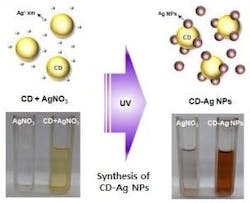Carbon-dot-supported silver nanoparticles boost polymer LED and solar cell performance
Ulsan, Korea--Researchers at the Ulsan National Institute of Science and Technology (UNIST) say they have developed a plasmonic material that boosts performance of polymer LEDs (PLEDs) and polymer solar cells (PSCs) while keeping their structure simple and their costs low. The material consists of carbon-dot-supported silver (CD-Ag) nanoparticles, which produce a surface-plasmon-resonance effect that leads to increased radiative emission and light absorption.
Organic optoelectronic devices are cheaper to make than inorganic devices, but further improvements in efficiency are needed before there can be widespread commercialization of these technologies. Plasmonic nanoparticles can boost efficiency; however, the contrary demands of PLEDs and PSCs mean that there are few metal nanoparticles that can enhance performance in PLEDs and PSCs at the same time.
The material prepared by the UNIST team is easy to synthesize with basic equipment and has low-temperature solution processability, enabling roll-to-roll mass-production techniques suitable for printed electronic devices.
“Our work is significant also because it anticipates the realization of electrically driven laser devices by utilizing CD-Ag nanoparticles as plasmonic materials,” says Byeong-Su Kim, one of the researchers. (The CD-Ag nanoparticles consist of carbon, hydrogen, and oxygen with a quasispherical structure in which the carbon shows the structure of crystalline graphite.)
The team demonstrated PLEDs that achieved high current efficiency from 11.65 to 27.16 cd/A and luminous efficiency (LE) from 6.33 to 18.54 lm/W. PSCs produced in this way showed enhanced power-conversion efficiency (PCE) from 7.53% to 8.31% and internal quantum efficiency (IQE) from 91% to 99% at 460 nm. The LE and IQE are among the highest values reported to date in fluorescent PLEDs and PSCs, respectively. THe research results were published in Nature Photonics.
About the Author
John Wallace
Senior Technical Editor (1998-2022)
John Wallace was with Laser Focus World for nearly 25 years, retiring in late June 2022. He obtained a bachelor's degree in mechanical engineering and physics at Rutgers University and a master's in optical engineering at the University of Rochester. Before becoming an editor, John worked as an engineer at RCA, Exxon, Eastman Kodak, and GCA Corporation.

